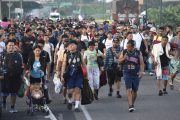Once again, the monthly numbers from Customs and Border Protection show that President Trump is right: Illegal immigration at the border is an emergency.
The bad news came in a 20-minute briefing from top CBP officials, including commissioner Kevin McAleenan (shown, right).
Border agents face an unprecedented invasion of illegal aliens whose new way to enter the country and stay is to arrive in clusters and claim they are families.
Raw Numbers
February’s data are truly frightening. Border agents caught 66,450 illegal aliens trying to cross the border between lawful ports of entry; 36,174 were in family units, 6,825 were unaccompanied minors.
The total is a 156-percent increase from February 2018, when border agents nabbed 26,666 illegals. In other words, the number of family units caught in February 2019 exceeds all illegals apprehended in February 2018. Just more than 5,000 family units crossed illegally last year.
Inadmissible aliens stopped at ports of entry were 9,653; 4,211 were in families and 424 were minors.
Total apprehensions in both categories was 76,013, a 107-percent increase from February 2018.
Thus far in fiscal 2019, border agents have collared 268,044 illegals crossing between ports of entry, including 136,150 as families and 26,937 minors; again, almost double the 136,209 caught last year.
Adding inadmissibles collared at ports of entry brings total apprehensions this year to 318,407, including 158,118 as families and 28,976 children.
Last year’s total for both categories through February was 187,097.
Officials: It’s a “Crisis”
Brian Hastings (shown, left), CBP operations chief, observed that a “A lot of folks don’t understand the big change in the demographics we’re seeing.”
Hastings said that 70 percent of illegals used to be Mexicans, who were easily returned home. Now, 70 percent are from the Northern Triangle of Honduras, Guatemala, and El Salvador, and again, most are arriving as “families.”
Last October was the first time family apprehension outpaced single adults, he said. This February, families and minors were 65 percent of the illegals caught. The number for the year is 60 percent.
The numbers are worrisome, he said, because illegals know they won’t be deported if they arrive with children and file phony asylum claims. And the trend will increase because “it’s well-known at this time that adults with children will not be detained during the immigration proceedings for illegal entry. The word of mouth and social media quickly gets back to those in the Northern Triangle countries, that if you bring a child you’ll be successful.”
But many if not most of those claims are phony, he said. Since April of last year, CBP has dealt with nearly 2,400 fraudulent claims of families, including liars who said they are under 18.
Another “dangerous trend” is large groups, defined as 100 or more, trying to cross. This fiscal year, CBP has caught 70 of those groups, totaling 12,000 apprehensions. Last year, just 13 such groups crossed the border; in 2017, just two. If the trend continues, he said, border agents will catch 174 large groups with 29,000 deportable illegals.
Problem is, those groups are crossing in remote rugged areas that are quite far from CBP facilities, transportation, and medical care. “Even more troubling … the drug trafficking organizations are utilizing these groups … to divert our agents away from the national security border mission and use them as a diversion to cross drug load.” Smugglers have tried the tactic four times recently.
As well, Hastings said CBP is dealing with “significant increases” of sick illegals who require medical care.
CBP sends about 55 illegals a day for medical care. The number reached 63 in December. He expects to send 31,000 illegals, up from 12,000 last year, for medical care. Since December 22, agents have spent more than 57,000 hours at hospitals or medical facilities at a cost of $2.2 million in CBP salaries. From 2014 to 2018, he said, CBP has spent $98 million on illegal-alien healthcare.
“Each and every day,” he said, 25 to 40 percent of CBP manpower goes to the care and maintenance of illegal aliens. “They’re pulled from the national security missions to do these things.”
The situation, he said, “is unsustainable for border patrol operations.”
McAleenan added that the large groups are traveling to the border on buses in “much shorter smuggling cycles.” One of those groups contained 334 illegals.
McAleenan said last year’s 38,000 asylum claims at ports of entry was a 120-percent increase from 2017. This year, the number is up 90 percent from 2018. Sixty percent are claiming fear of return to their countries.
The 76,103 illegals caught crossing the border and at ports of entry is the highest for February in 12 years. That number includes 40,385 individuals arriving in families and 7,249 unaccompanied minors. McAleenan said the number of illegals arriving in families caught thus far in fiscal 2019 through March 5 now exceeds last year’s record total of 161,113. Border agents caught 158,118 illegals entering in family units through February, meaning another 2,995 individuals have arrived in families since March 1.
“It should be very clear,” he said, that such “alarming trends … present both a border security and a humanitarian crisis.”
Photo: AP Images





